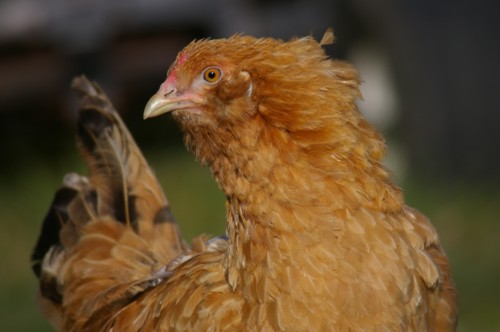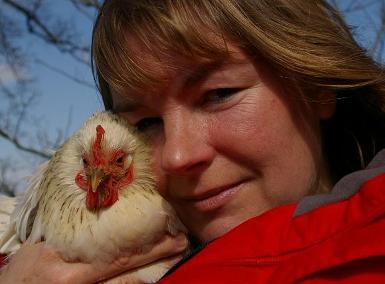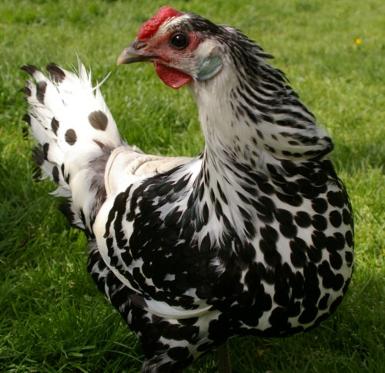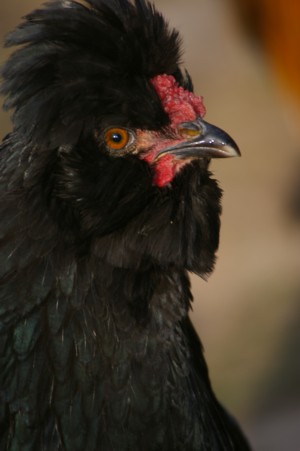Laura, Lizzy, Hannah and Lilly Marlene
Laura is the happiest of the bunch. She was born with a curled toe, but this never seems to bother her. She is the smallest of the 7 Araucana's that joined us here in France.
The Araucana chicken originated from Chile. When the Spaniards arrived in South America, bringing with them their poultry, they found that the indigenous Indians had their own breeds which soon crossed with the imported stock. However in the High Andes there were many areas where the terrain made conquest impossible and the Arauca Indians of Northern Chile were never conquered so their poultry remained pure and led to the name Araucana. Pockets of Araucana can still be seen in the Amazon Basin and in isolated areas in the high fincas of the Andes Range.
Laura, like her aunts and sisters, is a prolific layer of good-sized eggs and is a very hardy bird. The eggs have a strong shell and are unique in that the colour permeates throughout the shell. Their colour is green and quite popular amongst our French friends.
Laura
Date of birth: 10th of August 2007

I remember the day
that we got Lizzy just
like yesterday. We were still enjoying the two little chicks we had
rescued from
the poultry farm. So we decided to buy some more chickens. I did a
search on the
internet. There are so many wonderful breeds.
It was October and in a nearby
village they had organised a country fair. It was just after lunch. I
phoned our neighbour, even disturbed
her siesta, to ask whether she wanted to join us, so that she could give
us some advice. She
was delighted to come with us. Armed with our list we entered
the building and the crowing and cackling greeted us. As well as
chickens and
ducks, they had rabbits and little birds too.
For such a little fair they had quite a wide range of breeds: java bantams, silkies, cochins and some bigger breeds of which I can not remember their names. But of course the ones on my list were not there. From the start our eye fell on this little frizzle Cochin cockerel and his sister. But the Silkies were gorgeous too. It was a very difficult decision to make. But now that I have enjoyed having the cochin bantams for quite a number of years I am so glad I went for Frizzy and his sister Lizzy.
Lizzy got to the age of 7, when she also got Marek's disease. This photo was taken a couple of hours before she was put to sleep on the 25th of March 2010.
Lizzy Date of birth: 15th of August 2003

Hannah has left us for quite some time now. Previous summer she passed away. Those were warm and humid days.
When I opened the runs, Hannah was always first out and disappeared straight away into the barn. I knew that she had made a nest with many eggs on an old overall. As I had just taken away all her eggs the day before, she came running out of the barn making a lot of complaining sounds. Because this is how Hannah was. A loud bird that couldn't be missed. I can still remember her flying and running from one side of the barn to the other, looking for her eggs.
The rest of that day the chickens were very quiet. It was hot and they disappeared under a bush. When I did my evening rounds most chickens had already entered their night house. But Hannah wasn't there.
She wasn't on her nest either. Then I saw something black and white under a shrub. It didn't move. It was Hannah, lying on her side. Dead! I was devastated. There I sat with a dead Hannah on my lap. I couldn't believe it as she had been so lively and hadn't shown any signs of a disease.
The vet did an autopsy and discovered that she had a lot of fat around her liver and that her liver had been bleeding. This was probably triggered by the hot weather. She had what they call fat liver syndrome.
What had happened was this. It wasn't only for the eggs that she disappeared into the barn everyday, but for the cat food we left there for our stray cats. That day (and this was most certainly not the only day) she had eaten too much cat food which turned out to be fatal for her.
A couple of days later I found two more of her eggs hidden away in the barn. About those I'll tell you more in the next story.
Hannah Date of birth: May 2007

They say that having Marek’s disease in your chicken house means that you can’t have chicks, unless you vaccinate them on the first day after they’re born. In the United Kingdom experiments have been done, where chicks were born in a house contaminated with the Marek virus. These chicks had been contaminated but didn’t get any symptoms, as they had built up antibodies, like vaccination does.
In the summer of 2008 we lost our
Hamburgh Hannah to
the extreme warmth. From one moment to the next she died, lying
underneath a shrub.
In the barn I found some lost eggs of hers. These were the only things
of hers, left
to me after she died. So I cherished them and decided they had to be
hatched by a
hen no matter the cost.
Having the English experiment in mind, a breeder and the vet suggested putting the eggs under a broody hen in the night house despite Marek’s. After only a couple of days one egg broke. The other chickens were fighting for the nest. I separated the broody hen from the rest and 3 weeks later Lilly Marlene was born. She was a healthy little chick. As Lilly Marlene was on her own I could follow her development very closely. Almost every day I took some photo’s of her. She became a splendid chicken, with the elegant lines of Hannah her mum and the boisterous character of her dad Stevie, the Houdan.
Until the autumn of 2009, when she became lame. We had to put her down. After autopsy the vet came to the conclusion it was Marek's disease after all.
